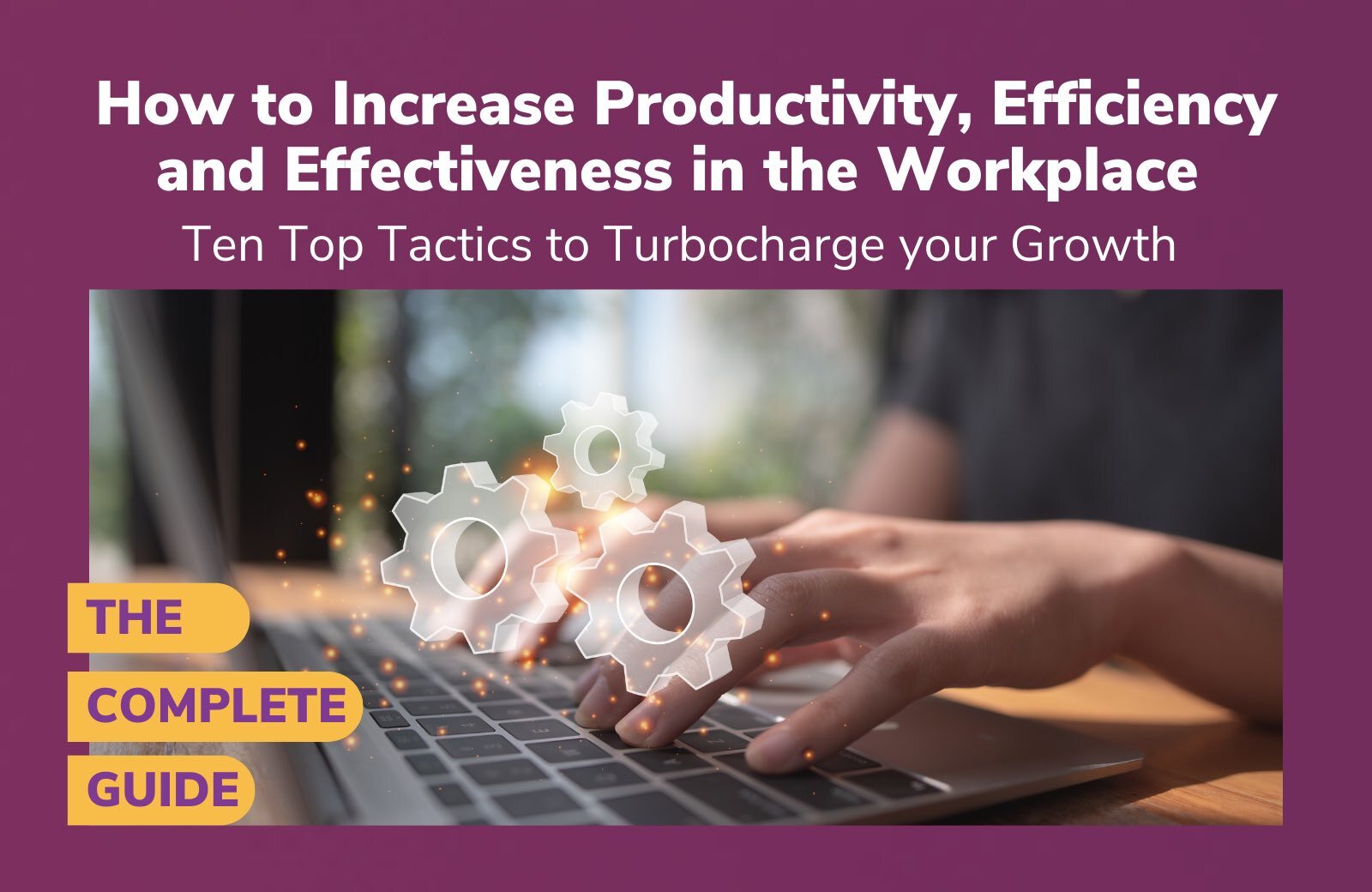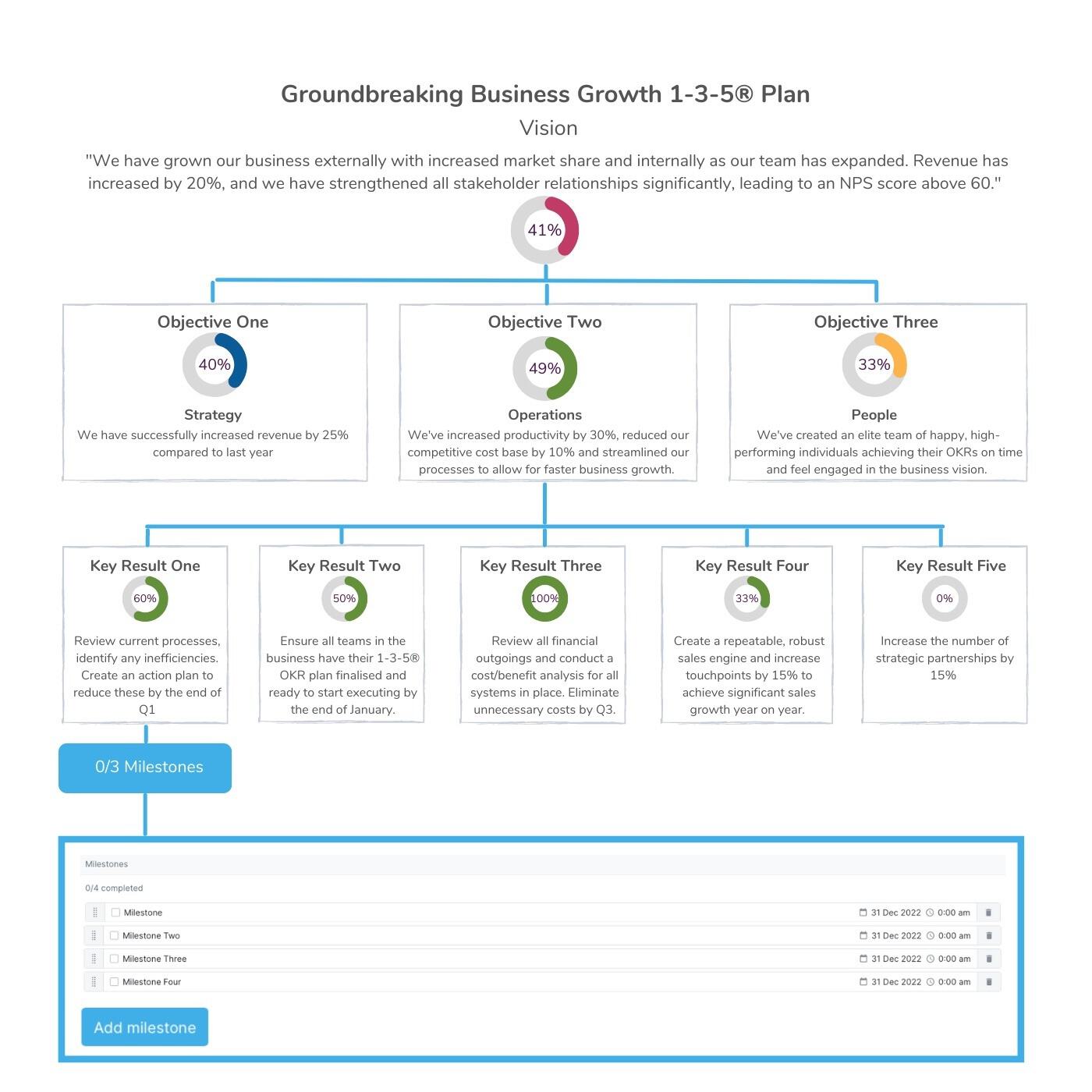
Last updated 8 July 2022 ·

Exhausted and worn out, we all experience times when we could benefit from increased productivity, efficiency, and effectiveness in the workplace. Whether you’re a leader, a manager or an employee, you’ll no doubt appreciate some guidance on how to increase your overall performance at work. Not only will you get more done, but you’ll get it done faster and better than before, raising your profile within your team and the broader business in the process.
A healthy office environment is one where employees are engaged, efficient, and effective in their work. In any workplace, it’s essential to ensure your employees are engaged and productive, not just from an attitude or moral standpoint but from a pure business perspective. Engaged employees are motivated to do their best work and stay with the company long-term, leading to higher productivity, efficiency and effectiveness overall. If you want to ensure your staff remain engaged this way, you need to focus on planning some effective initiatives to achieve that outcome.
We live in a world where time is money. If you can save time while working effectively, it will result in greater profits for your business. How is this higher state of optimum productivity, efficiency, and effectiveness? These days it’s more about working smart in an agile and flexible way than working hard for endless hours.
We’ve created the ten top tactics to consider when focusing on achieving a lasting and impactful increase in team productivity, efficiency and effectiveness that will produce faster results across your business.
Contents
- Productivity, Efficiency and Effectiveness Explained
- Productivity
- Efficiency
- Effectiveness
- Top Ten Tactics to Turbocharge your Growth
- Create clear, focused goals
- Plan out your day
- Set priorities
- Work deeply and take breaks
- Delegate
- Record your accomplishments and celebrate success
- Forget multitasking
- Play to existing strengths and skills
- Communicate the bigger picture
- Stay disciplined
- Summary
Productivity, Efficiency and Effectiveness Explained
Productivity
Productivity is measured in terms of output rate per unit of input. According to the UK productivity puzzle, this output rate has slowed since the financial crisis. Productivity is essential for all businesses as it represents the work and the pace of strategy execution. Often forming a necessary part of goal-setting, achieving faster business growth starts with improving productivity and performance.
According to Forbes, 12 tried and tested techniques can make your business more productive. These include setting clear deadlines, taking structured breaks, avoiding unproductive meetings, establishing a tighter focus and concentrating on progress, not perfection. It’s no coincidence that these techniques can be achieved using OKRs, objectives and key results. This goal-setting framework clarifies what’s expected of people at all levels. It helps direct focus and resources to become more productive, efficient and effective in producing an enhanced result.
Efficiency
Efficiency is different. People can become very efficient in their tasks; however, unless they follow a structured plan of highly focused strategy execution, it’s prevalent for people to focus on busyness instead of business. They do things efficiently the way they’ve always done something out of habit, with little thought of what’s the best way to do it under the current circumstances. People like to be busy, but this can be unproductive without clear direction. You can become highly efficient in making a round of hot drinks or tidying your desk, but this isn’t going to affect business performance directly.
One of our favourite quotes here at Reclaro is from Peter F. Drucker:
It’s more important to do the right thing than to do things right.
An effective leader should focus on doing the right things to move the business forward. Efficiency is still important as it is concerned with minimising the resources required to produce the desired result. It is the ability to do something successfully with minimal input, and so with clear direction and tight focus, efficiencies can be improved and put to productive use.
Implementing an OKR framework will help leaders identify business areas that have gradually become less efficient over time. Once identified, you can take appropriate action to improve efficiencies within those areas, leading to higher productivity, efficiency and effectiveness when direction and focus are prevalent.
Effectiveness
Effectiveness refers to how successful something is in producing the desired result. Within a business sense, effectiveness relates to the effects of employees’ actions. Employees demonstrating efficacy in the workplace are producing high-quality results.
Like productivity, increasing effectiveness means aligning a more focused effort towards achieving strategic goals. This requires a planned, strategic approach with measurable, quantified steps that ensure timely progress. Once again, this is exactly what you get with OKRs, objectives and key results!
To quote Peter F. Drucker once again,
Efficiency is doing things right; effectiveness is doing the right things.
Once you combine all three of these, that’s when the magic happens!

Top Ten Tactics to Improve Productivity, Efficiency and Effectiveness
1) Create clear, focused goals
One of the best ways to increase productivity is by setting short-term goals, and according to Inc.com, you are 42% more likely to achieve your goals if you write them down.
It’s easy to get caught up with long-term goals such as sales targets, revenue growth, and business expansion, but these should be secondary objectives when starting with a new job or project. It’s better to set smaller, realistic targets that can be achieved within a month or two and create an action plan to help you reach them - and then the most crucial part - following through on them!
Goals are an essential component of a business plan - they define what your business is aiming for. Without goals, there is nothing clear to aim for, nothing to apply purpose or ambition to. So why not formalise goal-setting within your company? Creating goals at work can also help you feel more empowered as if you’re taking charge of your career.
Google uses OKRs, Objectives and Key Results to set goals with its employees - and it has been doing so since 2010 when it employed just 40 staff. These objectives and key results should be specific and measurable and include deadlines.
For example, setting the objective to tighten customer support response time by 50% by December 31st will give everyone on your team something to shoot for each quarter or year. Even better, once this objective is broken down into a series of measurable key results, it will help employees identify the actions they can take towards achieving this; hence they become more engaged with the mission. When employees have clear objectives and measures of success, they become more involved in their jobs because they know exactly how their performance impacts overall company success. Furthermore, employee engagement has increased productivity levels across entire organisations - meaning companies will benefit from this goals-setting exercise.
2) Plan out your day
When you plan your day, you take control of your day instead of arriving and jumping straight into emails, letting your day unfold chaotically before you! The best way to start the day is to reflect on your goal and progress so far and remind yourself of where you are in your current plan. OKRs, Objectives and Key Results can help you map your day in this way.
If you have your eye on a big goal, then it’s OKR time. This goal-setting method is becoming more and more popular across the globe, as hugely successful companies like Google, Facebook, LinkedIn, Spotify, Airbnb, Uber, and Trello all attribute a significant part of their success to the OKR method. The main benefit of using OKRs is that it helps you focus on goals that align with business objectives.
Each day when you arrive at work, review your OKR plan and create a list of tasks that will contribute toward that big picture goal. At the end of each day, take just a few minutes to review how well you did against those OKRs. Did you hit all or most? Did some slip through? If so, adjust accordingly for tomorrow. Have you moved forward? Having this focused approach dramatically avoids inefficiencies creeping in.
For most of us, daily work has moved beyond a simple to-do list that keeps getting added to without any clear direction or prioritisation. Having OKR plans naturally links up the daily to-do task lists with top-level strategic focus points such as why those tasks are so important and how much time they should take.
Assess the importance and validity of any meetings you may be invited to attend. Are you required to attend each of these meetings? If you have valid input to add, then yes, of course, you are; however, there is a tendency in some workplaces to end up having meetings for meeting’s sake. Avoid this at all costs as this type of activity will waste resources and certainly jeopardise your productivity, efficiency and effectiveness.
3) Set Priorities
Prioritising helps us focus on what’s most essential and provides a reference point against measuring how effectively we achieve those critical tasks. Start by creating a list of your long-term and short-term goals. This will give you some perspective on what needs to be done right now and what can wait. Be sure not to overwhelm yourself with all you want to accomplish. You should set a target of 1–3 key results you want to achieve each week. If you’re feeling ambitious, try one per day.
Once you have these priorities set, it’s time to make them happen!
Keep a planner nearby so that when an idea pops into your head or something comes up during the day that needs attention, you can write it down immediately and then schedule time later in your planner to work on it. If it takes less than two minutes to action an item, do it immediately! If it takes more than two minutes, write it down and schedule a time to work on it later.
As they say: The best way to get started is to quit talking and begin doing. The same applies here; getting things out of your head and into a structured plan helps them become real, even if they don’t happen immediately.
Use Checklists: When working on tasks that require multiple steps or actions, break those steps down into smaller pieces. The Reclaro OKR software allows you to break down key results into smaller, more manageable areas of focus called Milestones, as shown in the image below. So when ticking off 1-3 key results per week seems too overwhelming, after all, it depends on the scope of those key results as to whether that’s even possible or not, you can instead focus on ticking off a certain number of milestones. This way, you can stay focused without becoming overwhelmed and still make progress.

4) Work Deeply and Take Breaks
In the book Peak Performance by Brad Stulberg and Steve Magness, they recommend getting into a high state of concentrated deep work for 52 minutes and then following this with 17 minutes of rest. However, Cal Newport’s book Deep Work: Rules of Focused Success in a Distracted World suggests creating an environment without distraction for a prolonged period of deep work lasting up to four hours at a time. The latter is deep work at an advanced level and takes some practice. The point is that an excellent way to boost your productivity, efficiency and effectiveness is to remove all distractions from your immediate environment, turn your phone off, close your emails etc. and enter into a state of deep work. Concentrating on a task for an extended period also has a beneficial effect on mental health. Successful people like Bill Gates operate this way, tailoring their work schedules to free themselves of distraction.
According to Newport, the term ‘deep work’ is defined as: “Professional activity performed in a state of distraction-free concentration that pushes your cognitive capabilities to their limit. These efforts create new value, improve your skill, and are hard to replicate.”
Such deep work should, of course, be followed by a well-deserved break. Get up and move around. Take some deep breaths or admire the view from the window. Then get back to work. This will give your brain time to clear its short-term memory and refresh your thinking. It can also be helpful to change your environment during these breaks; try walking outside instead of sitting at your desk. If possible, step away from your computer altogether. If you have difficulty getting away from your desk, turn off all distractions (noise-cancelling headphones are perfect for blocking out ambient noise) and listen to focused music while you work.
A study by Dr Adrian Furnham, Professor of Psychology, author and academic, showed that listening to music improves productivity levels by as much as 15% compared with silence! However, this depends on the type of music you choose. YouTube has some great deep focus music to improve concentration.

5) Delegate
Delegating tasks means not having to do all of your work yourself. The simplest, most structured way to delegate effectively whilst also ensuring everyone is working towards the common business goal is by using OKRs, Objectives and Key Results. OKRs provide a structured way to delegate work that gives visibility and transparency. OKRs are usually set at the CEO level and cascaded throughout all levels of the business. Leaders and managers within the company can then create their own OKRs corresponding to the CEO OKRs and cascade these amongst their teams so everyone knows exactly what they’re responsible for and how they can apply themselves for the best results.
For example:
Objective: Increase revenue by 20% through new partnerships.
Key Result 1: Attend 10 trade shows to identify suitable partnership businesses.
Key Result 2: Clarify our partnership offering, and create a package attractive to other businesses and ready for launch at the end of Q1.
Key Result 3: Gather data and build a target list of 200 potential partner contacts to reach out to.
Key Result 4: Reach out to 20 potential partner contacts monthly, presenting a compelling pitch and converting 15%.
This overall objective could be owned by the Head of Partnerships working with a team of marketing and sales professionals. Key result 2 may be delegated to marketing, whilst key result 4 would be more suited to sales and delegated accordingly.
OKRs provide a great way to delegate because it’s not just setting tasks like ‘I need you to do this.’ Instead, it’s more about saying, ‘I need you to achieve these results,’ says Jason Lemkin, CEO of SaaStr.
An effective way to get people to achieve specific results is to allow them the autonomy to decide how best they can focus their efforts to achieve those results. Instead of micro-managing, communicate the plan, the overall business vision and goals and then let them work out how they can positively impact that.
So, if your objective is to increase revenue by 20%, make sure you have a clear, concise plan detailing how that will happen, comprised of a series of objectives and key results that can be cascaded throughout your business.
If you haven’t already created OKRs for your team or organisation, set aside some time to look at these additional resources around goal-setting. In addition to making delegation more manageable and more effective, clearly defined goals are essential for productivity, efficiency, and effectiveness:
Eight Free OKR Templates & Examples
The Productivity Puzzle Cost Calculator™
6) Record your Accomplishments and Celebrate Success
Many of us make New Year’s resolutions that include being more organised and forming better habits both in and out of work. However, very few of us keep track of our habits and accomplishments. To track your productivity, efficiency and effectiveness using OKRs, you could use a Google doc, excel sheet, an OKR journal/logbook, or better still, OKR software to track OKR progress, performance and achievements. Recording progress against specific objectives, key results and milestones also help hold yourself accountable for your commitments by recording key accomplishments from each day. Following these measures is what enables you to identify your rate of success.
One advantage of using an electronic tool is that you can automatically sync deadlines to your calendar to ensure you stay on track every week, month, and quarter. You could also set up categories for tracking goals related to team collaboration, leadership development and learning/development opportunities. The important thing is to have a system in place so that you don’t forget to record these accomplishments - even if it’s just a quick note about what happened during your day. The more detailed and regular, the better! It’s important to celebrate your success along the way and enjoy the recognition and reward that may come about due to that. Celebrating success along the way can provide the boost everyone needs to increase productivity, efficiency and effectiveness as they work on achieving their goals.
In addition to keeping track of accomplishments over time, you should also keep track of what happens when things don’t go according to plan to make essential adjustments for the next quarter.

7) Forget multitasking
The New York Times describes multitasking as ‘a biological impossibility’ and something which may make you feel like you are being more productive. Still, you are not only prone to making more mistakes, but you are also stifling creativity and innovative thinking in the process.
Have you ever been so overwhelmed with your workload that whilst trying to focus on one task, you worry about all the other tasks you still have to do? So in response, you may attempt to do a few things simultaneously. Usually, this involves having a telephone conversation while typing or reading emails and a slight frazzled feeling afterwards as neither task is straightforward in your mind. Our brains have limited cognitive capacity when switching back and forth between functions demands extra hard work handling multiple thoughts at once. Your ability to get things done depends on how well you can focus on one task at a time.
“Multitasking is not humanly possible; people are much more efficient if they monotask,” said Earl K. Miller, a neuroscience professor at the Picower Institute for Learning and Memory at the Massachusetts Institute of Technology.
Genuinely innovative thinking arises when we allow our brains to follow a logical path of associated thoughts and ideas. This is more likely when we can focus on a single mental pathway for an extended period.
Dr Miller also states that the brain is like a muscle: It becomes stronger with use. As with physical exercise, the more we strengthen our mental connections by focusing on one task to the exclusion of others, the better we can perform. So there we have it, proven research suggesting it’s more effective to do one thing at a time. Don’t spread yourself too thin each day. Goals should be S.M.A.R.T.: Specific, Measurable, Attainable, Relevant and Time-bound. If a goal isn’t S.M.A.R.T., it may not be achievable or relevant to you today – or ever, for that matter!
Start with one goal and break it down into smaller action steps that are specific, measurable, attainable, relevant and time-bound. Then prioritise each of those by importance, so you know what is most important to work on first. Write down each action step with due dates, so you have something concrete to work towards each day. You can also break your goals into weekly tasks and monthly actions if necessary.
However, more recent research reveals that goals should be FAST instead of SMART. In the book Pinnacle: Five Principles that Take Your Business to the Top of the Mountain, Steve Preda and Gregory Cleary state that in a 2018 white paper from MIT’s Sloan School of Management Donald and Harley Sull continue to make the case for FAST as an effective execution strategy, in place of SMART. FAST stands for Frequently reviewed, Ambitious, Specific and Transparent.
8) Play to existing strengths and level up
Identifying key strengths and allocating work according to those will help you become more productive, efficient and effective as a business. Everyone has different skills and strengths, so if you can leverage these to your advantage, it will set you up for a higher level of success.
Before allocating work out or as you cascade OKRs, objectives and key results amongst all teams, consider who is best matched to take on which elements of the centralised OKR plan and how these objectives will filter down various specialisms.
Once these existing strengths and skill sets have been identified, offer employees a chance to build on these with further training and development to empower them in their areas of expertise. Naturally, employees will learn on the job. However, the best way to step things up is to engage in additional training to enhance performance even further.
As all teams and individuals get set up with their OKR plan to work towards, ensure you combine this with an element of personal development so employees know how they can make a difference to themselves professionally and positively influence business growth. Such personal development could include coaching, mentoring, increased responsibilities or attending workshops. This will help improve an employee’s productivity, efficiency and effectiveness.
9) Communicate the bigger picture
Clear, concise communication is fundamental to achieving high productivity, efficiency and effectiveness in your business. Sharing top-level business goals and objectives amongst all teams go a long way to ensure they know what the company is aiming for, encouraging employee engagement and motivation. An OKR software tool can help structure and cascade your strategy, providing visibility of top-level business goals and clearly showing how OKRs at each level feed into those. Such visibility and transparency of roles and responsibilities keep all employees aware of how others are progressing. This helps align teams through hard work and shared goals, improving team togetherness and employee satisfaction. They can clearly see their hard work and concentrated effort’s direct impact on the overall business performance, enhancing their productivity, efficiency and effectiveness.
Do be aware of how all-consuming email communication can be. A study by Adobe revealed that the average worker on UK minimum wage earns £6,000 per year for time purely spent on emails! This was calculated from an average of 3.1 hours per day, 15.5 hours per week, equating to a shocking 20 weeks per year! To become more productive, this time needs to be reduced considerably. This includes checking, reading, and sending emails. Additionally, there are many software tools to make daily, regular communication amongst teams quicker and easier. Replacing email communication with an instant messenger app can help.
How many times have you turned up at work and struggled to decide what to work on first? Such a lack of clear direction and effective decision-making can cost a business in wasted time and resources. How can someone be their most productive, efficient and effective if they can’t see the bigger picture or struggle to decide what work they should be doing? Using OKRs is a highly effective way to reduce inefficiencies like this. They present a focused work plan so employees are equipped to make better and faster decisions.
Before you start your workday each morning, spend a few minutes reviewing your OKR plan. Determine how much time you’ll need for the most pressing activities. Then try to get as much done during your most productive times as possible. Many studies have taken place to identify our most productive time of the day, some say during the first few hours in the morning, whilst others say it’s around lunchtime. Research conducted by Tic Watches and documented in HR News reveals that the most productive time of the day can alter according to the profession. A common trend across all occupations, however, is that the morning, between 9 am and 1 pm seems to be the most popular time that workers feel their most productive and creative selves. Try to prioritise high concentration tasks and deep work for your most productive time of the day and leave other less intensive tasks until after that. Don’t waste time working on something intensive when you know it won’t be as effective.
By knowing where you are going and how much time it will take to get there, you can better plan around your specific needs and tendencies. You may also want to consider working from home one or two days per week if possible - the quiet environment can help increase productivity and reduce distractions (not to mention lower stress levels). If you have trouble with motivation, use external cues to spur yourself into action. As previously mentioned, checking emails can drain your time, so schedule specific times each day to go through emails and close your inbox at other times. Leave your mobile phone in a different room while you’re working so that incoming calls and constant notifications don’t interrupt what you’re doing. With some practice, these techniques can help develop positive habits over time.

10) Stay Disciplined
It’s easy to want to do everything at once. Disciplined professionals know how to prioritise their tasks by identifying their highest value activities (HVAs) and focusing on those things first. Using OKRs, objectives and key results provides a structured way to plan your workload and identify your own HVAs.
Think of your priorities as you would a guest list for a wedding. You wouldn’t invite everyone because that would be far too many people; instead, you have an appropriate number of guests based on your budget, time available, etc. The same is valid with your work. Trying to do everything will take longer than necessary and distract you from your most important goals. Stay disciplined by setting clear priorities - and then stick to them! This will help you avoid feeling overwhelmed and stuck while also helping to improve your productivity, efficiency and effectiveness, leading to higher success.
Spend just 5 minutes each morning reviewing your goals and reminding yourself of what’s most important. If possible, write out your goals during this time, so you approach your workload with a much more focused mindset.
Conclusion
To be successful in any office setting, it’s essential to set a good example for your co-workers. The small things matter - being reliable, on time, and attentive are all qualities that will lead to improved productivity, efficiency and effectiveness as long as they are combined with a strategic, highly motivated mindset. It’s also essential that you work well with others; collaboration and communication are vital. Understanding other people’s workloads and pressures can massively help drive empathy and kindness, resulting in a culture of helping each other succeed instead of competing aggressively. Using OKRs provides a highly effective way to combine all these benefits whilst structuring work, so everyone is aligned towards achieving the same common business goals.
If you are keen to try using OKRs in your business but are unsure where to start, download The OKR Builder™ today. It includes a step-by-step guide on creating compelling OKRs that cascade seamlessly throughout all teams in your business.





